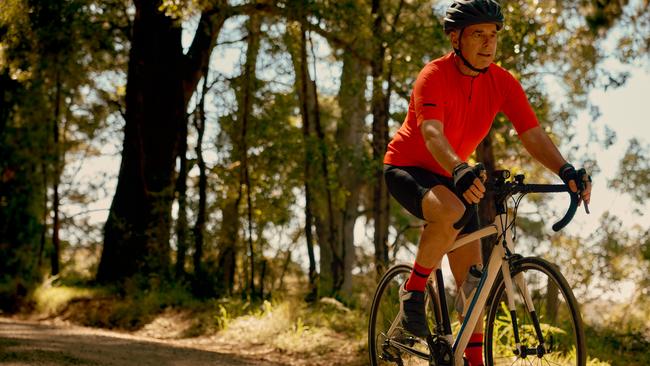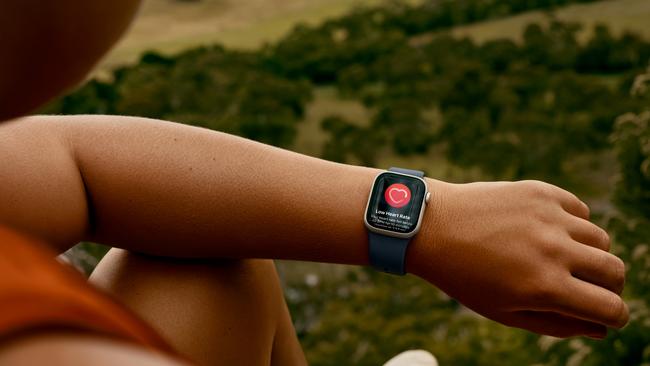Inside Apple’s healthcare strategy and why its placing its bets on your wrist
Apple Watch, launched almost a decade ago, is becoming more than just an upmarket timepiece, it’s a springboard for the tech giant’s dive into healthcare.

Apple is deepening its efforts to transform its near decade-old watch into a universal health monitoring device that it says can help save people’s lives.
The strategy is legally fraught but has the potential to inject further profits into the $US2.80 trillion ($4.3 trillion) company.
Health insurers – including Medibank – are offering incentives to customers who wear smartwatches and other wearables to encourage healthier lifestyles and potentially avoid expensive hospital claims. Combined with a more health-conscious and ageing population, this is expected to bolster sales, with the overall smartwatch market forecast to grow 6.84 per cent annually, hitting $US62.46bn by 2028, according to Statista.
But Apple’s health monitoring strategy has pitted it directly against medical device companies, which have been developing the tech for years and defend their patents vigorously.
Apple has already been suspended from selling certain models of its Apple Watch in the US as part of a patent feud with company Masimo over its blood oxygen feature. The ban has not affected Australian sales.
Deidre Caldbeck, the executive in charge of Apple Watch product marketing, said the company is “working very hard to bring a solution to that issue here in the US” and healthcare would be a key part of future Apple Watch innovation.
“We are always going to focus our innovation and our investment in areas of health where we can make an impact on a user’s life,” Ms Caldbeck told The Australian.

Apple – which lost its mantle as the world’s most valuable company to Microsoft earlier this year – initially envisaged that the Apple Watch would be more than just an upmarket timepiece, planning an array of potential health features, such as measuring stress levels.
But many of those features were ditched ahead of its launch in April 2015 because they were unfeasible or difficult to calibrate.
However, it was able to pack in a range of technology such as heart rate monitoring – including the ability to perform an ECG and detect atrial fibrillation. As Apple focuses more on catering to the needs of an ageing population, it has also built in a fall detection feature that can even automatically call an ambulance and alert a family member or friend – even if the user is unconscious and doesn’t have a phone.
“As we age we do tend to see some of our balance and strength and coordination deteriorate. It just happens naturally. And so it does put you at higher risk of a fall,” Ms Caldbeck said.
“So the original feature was optimised for those older demographics and it was validated against real world data that we gathered over the years from those older demographics who, unfortunately, did fall because they started to lose balance.
“But what we learned - just like really with a lot of our health features - is that these can be impactful to users of all ages.”
Incorporating more health monitoring and safety features has proved a winning formula, with Apple dominating the smartwatch market. It accounted for almost 60 per cent of all global sales in 2022, according to Counterpoint research.
But Ms Caldbeck said many of Apple’s health features remained largely hidden to many consumers.
“We tend to refer to them as sort of these passive features. They’re just working in the background without you ever having to do anything.
“We have these really powerful motion sensors in Apple Watch that have been in there since the beginning. But they were primarily used for measuring movement during workouts or giving you that all day activity credit for your activity rings. But we were trying to figure out what else can we do with these motion sensors? What else can we do with safety features?”

For Lexie Northcott those features were lifesaving. She received an Apple Watch on her 16th birthday in 2019 but in the first year of use the device kept lighting up with low heart rate notifications.
“I’d just ignore it,” Ms Northcott said.
“But the notifications kept getting really consistent and kept coming and I’d be getting maybe four or five a day by the end. I’d get other people in my PE class to put the watch on and we’d go running and their heart rate would get maybe to 150 and mine wouldn’t get over 100.”
Dismissing it as being young and fit, Ms Northcott did not even mention it to a doctor until she needed treatment for a rash on her neck. But her mother Karla Northcott said they needed to push for an ECG.
“The doctor said, ‘you know, she’s young, low heart rate, don’t be concerned, it’s fine’. But we did want to get it checked out.”
An ECG was booked a week later. But a few days before she was set to visit the clinic again, Ms Northcott went on a hike and struggled to keep up with her friends and sisters.
“The adults came up slower, and yet found Lexie sitting on a rock not very well,” her mother said.
“In hindsight, she almost died at that moment but we didn’t know.”
It transpired Ms Northcote had a heart block – a condition where the electrical signals of your heart don’t conduct properly. She later saw a specialist in Melbourne and had a pacemaker fitted and is now back to exercising.
“I can’t believe how lucky she is to be here,” her mother said.
“I would have just gone to wake her up and she would be not with us anymore, or she would have been playing sport and just dropped. But the thing is that I find amazing is that if we hadn’t got that watch, we would never ever have found this out and Lex wouldn’t be here.
“I just couldn’t imagine what life would be if we didn’t have it. It was really, like... I just don’t want to go there.”

Bruce Mildenhall has a similar story. Six weeks after receiving an Apple Watch for his birthday in 2021, he went on a cycle ride in Victoria’s Macedon Ranges and was knocked off his bike by a kangaroo. He said his mind went blank after the fall but the watch automatically called an ambulance and alerted his wife.
“It was fairly explicit,” Mr Mildenhall said about the message the watch sent to his wife.
“It said ‘Bruce has had a hard fall, hasn’t responded, this is where he is’. When she got there I was in the back of the ambulance, just trying to work out what was going on because I had this massive neck brace on – I landed on my head – and they were just checking my fingers and toes to see whatever damage that might have been to my overall nervous system, I suppose to see whether I was paralysed.
“There was this bang, bang bang on the side of the ambulance and they put the window down and she said ‘You got Bruce Mildenhall in there and is he alive?’”
Mr Mildenhall wasn’t paralysed but “destroyed” his shoulder. “There’s still a bone missing from the shoulder joint. But I’d much rather be doing the physio and the work in the gym and trying to repair that than being in a wheelchair.”
Medibank chief customer officer Milosh Milisavljevic said “there is a big role for wearables” in encouraging healthier lifestyles and costly medical and hospital treatment. Medibank has been encouraging customers to connect their smart devices to its Live Better App, where they can accumulate rewards points as they become more healthy.
“The way we split it up is we’ve got general wellbeing and primary prevention through Live Better,” Mr Milisavljevic said.
“We’ve got hundreds of thousands of customers now that have their wearables linked. We’re able to track activity, we’re able to use that to provide nudges and incentives for healthy behaviour. And so that’s a very big part of how we’ve designed and how Live Better runs to encourage primary prevention and general wellbeing.
“Then we have our prevention programs, which are more targeted at specific risk factors or conditions. And the vast majority use wearables to track it.”





To join the conversation, please log in. Don't have an account? Register
Join the conversation, you are commenting as Logout